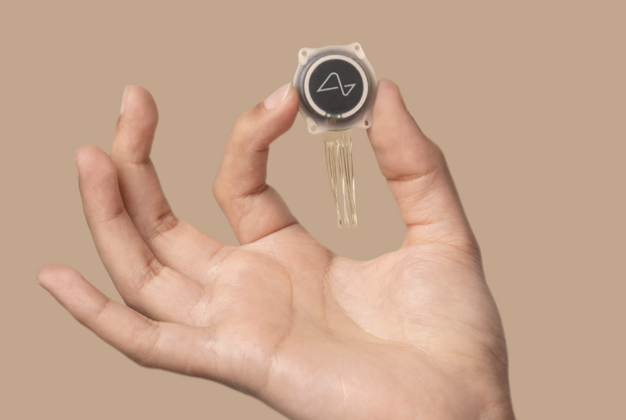
BCI steht für „Brain Computer Interface“: die Verbindung von Gehirn und Computer. Das US-Technologieunternehmen Neuralink hat am 19. September 2023 den Beginn einer klinischen Studie zur Erforschung von BCI bei der ALS mitgeteilt. Die amerikanische Aufsichtsbehörde FDA hat eine Genehmigung dieser Studie erteilt. Die Studie trägt den Titel: “PRIME Study: Precise Robotically Implanted Brain-Computer Interface”.
Das Grundprinzip von BCI bei der ALS besteht in der Implantation eines „Chips“ an der Gehirnoberfläche, mit dem neuronale Signale empfangen und für die Steuerung von Gehhilfen (und anderen Assistenzsystemen) genutzt werden sollen. In einem robotergestützten neurochirurgischen Eingriff wird ein Implantat an der Hirnoberfläche in der Nähe des „motorischen Zentrums“ (motorischer Kortex) positioniert. Über dieses Implantat werden geringe Hirnströme erfasst, die bei der Willensbildung einer Bewegung entstehen (z.B. bei der Intention einer Beinbewegung). Diese elektrischen Signale werden durch den implantierten Chip verarbeitet und in die Steuerung eines Gangassistenzsystems umgesetzt. Dieses Prinzip wurde bisher bei ausgewählten Patienten mit einer Rückenmarksschädigung eingesetzt. Dieses Verfahren befindet sich in einer frühen, experimentellen Phase der Erforschung und noch kein etabliertes Therapieverfahren.
In der Neuralink-Studie bei der ALS wird die operative und technische Machbarkeit sowie Verträglichkeit der Methode untersucht. Außerdem sollen erste Erfahrungen gesammelt werden, inwieweit die Verbesserung von motorischen Funktionen durch die Implantation des Chips und die Kopplung mit dem Gangassistenzsystem erreicht werden kann. Längerfristig wird beabsichtigt, dass Menschen mit ALS (und anderen neurologischen Erkrankungen, insbesondere mit Querschnittslähmung) in die Lage versetzt werden, die Gehfähigkeit zurückzuerlangen, obwohl schwere Lähmungen der Beine vorliegen.
Aufgrund des experimentellen Charakters der Studie (und der Begrenzung dieser Studie auf amerikanische Studienzentren) ist gegenwärtig noch keine direkte Versorgung von ALS-Patienten mit dem Neuralink-System möglich. Trotz dieser Einschränkung ist die Studie als wichtiger wissenschaftlicher Meilenstein zu betrachten. Auch aus einer gesellschaftlichen Perspektive ist die Studie zu begrüßen – durch die Bekanntheit von Elon Musk und die finanzielle Kraft seiner Unternehmen (Tesla, Space-X, X.com, vormals Twitter) ist von einer zunehmenden Aufmerksamkeit für die ALS und von einem Innovationsschub für Assistenztechnologie bei der ALS auszugehen.
Über Neuralink
Das US-Technologieunternehmen unter Führung von Elon Musk verfolgt die Integration von Hirnimplantaten zur Verbesserung von Hirnleistungen oder zur Kompensation von neurologischen Defiziten. Das Prinzip der Hirnstimulation wird mit dem Einsatz von Herzschrittmachern verglichen. In diesem Bereich der Medizin hat sich die Verbindung von Körper (Herz) und Technologie (Schrittmacher) bereits etabliert. Die Entwicklung von Hirnimplantaten ist jedoch wesentlich komplexer als in der kardiolgischen Medizin und ist daher als längerfristige Strategie zu bewerten.
Links
https://neuralink.com/patient-registry/
https://neuralink.com/pdfs/PRIME-Study-Brochure.pdf
Autor: Prof. Dr. Thomas Meyer
Elon Musk’s ‘Neuralink’ launches study of BCI in ALS
BCI stands for “Brain Computer Interface”: the connection of brain and computer. The U.S. technology company Neuralink announced on September 19, 2023, the start of a clinical trial to study BCI in ALS. The U.S. Food and Drug Administration (FDA) has granted approval of this study. The study is titled: “PRIME Study: Precise Robotically Implanted Brain-Computer Interface.”
The basic principle of BCI in ALS is to implant a “chip” on the surface of the brain to receive neural signals and use them to control walking aids (and other assistance systems). In a robotic neurosurgical procedure, an implant is positioned on the brain surface near the “motor center” (motor cortex). Via this implant, small brain currents are recorded that are generated during the volition of a movement (e.g., during the intention of a leg movement). These electrical signals are processed by the implanted chip and translated into the control of a gait assistance system. This principle has been used so far in selected patients with spinal cord damage. This procedure is in an early, experimental phase of research and is not yet an established therapeutic procedure.
In the Neuralink Phase 1 study in ALS, the surgical and technical feasibility as well as tolerability of the method is being investigated. In addition, initial experience is being gathered to determine the extent to which motor functions can be improved by implanting the chip and coupling it with the gait assistance system. In the longer term, it is intended that people with ALS (and other neurological diseases, especially paraplegia) will be able to regain the ability to walk even though severe paralysis of the legs is present.
Due to the experimental nature of the study (and the limitation of this study to U.S. study sites), direct care of ALS patients with the Neuralink System is not currently possible. Despite this limitation, the study should be considered an important scientific milestone. The study is also to be welcomed from a societal perspective – due to the high profile of Elon Musk and the financial power of his companies (Tesla, Space-X, X.com, formerly Twitter), it can be assumed that there will be an increasing awareness of ALS and an innovation push for assistive technology in ALS.

